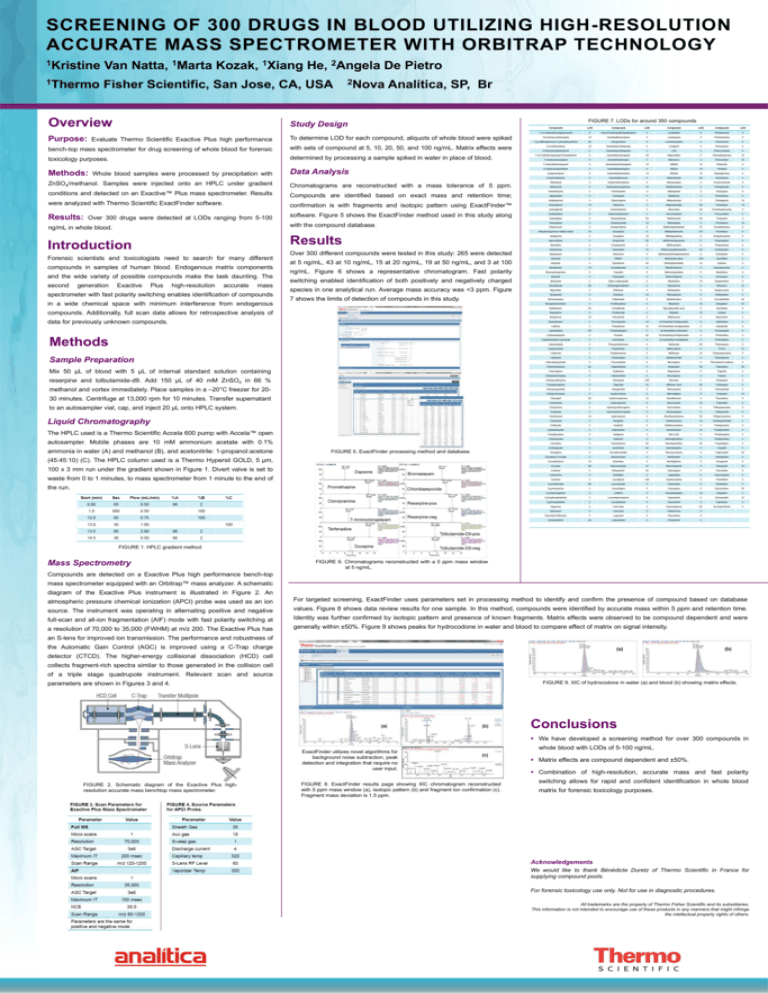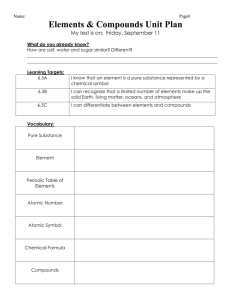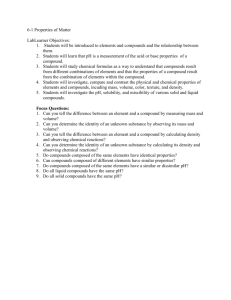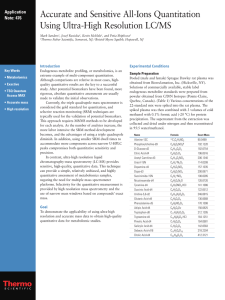screening of 300 drugs in blood utilizing high-resolution
advertisement

SCREENING OF 300 DRUGS IN BLOOD UTILIZING HIGH-RESOLUTION ACCURATE MASS SPECTROMETER WITH ORBITRAP TECHNOLOGY 1Kristine Van Natta, 1Marta Kozak, 1Xiang He, 2Angela De Pietro 1Thermo Fisher Scientific, San Jose, CA, USA 2Nova Analítica, SP, Br Overview Study Design Purpose: Evaluate Thermo Scientific Exactive Plus high performance To determine LOD for each compound, aliquots of whole blood were spiked bench-top mass spectrometer for drug screening of whole blood for forensic with sets of compound at 5, 10, 20, 50, and 100 ng/mL. Matrix effects were toxicology purposes. determined by processing a sample spiked in water in place of blood. Methods: Data Analysis Whole blood samples were processed by precipitation with ZnSO4/methanol. Samples were injected onto an HPLC under gradient Chromatograms are reconstructed with a mass tolerance of 5 ppm. conditions and detected on an Exactive™ Plus mass spectrometer. Results Compounds are identified based on exact mass and retention time; were analyzed with Thermo Scientific ExactFinder software. confirmation is with fragments and isotopic pattern using ExactFinder™ Results: software. Figure 5 shows the ExactFinder method used in this study along Over 300 drugs were detected at LODs ranging from 5-100 with the compound database. ng/mL in whole blood. Results Introduction Forensic scientists and toxicologists need to search for many different compounds in samples of human blood. Endogenous matrix components and the wide variety of possible compounds make the task daunting. The second generation FIGURE 7. LODs for around 350 compounds Exactive Plus high-resolution accurate mass spectrometer with fast polarity switching enables identification of compounds in a wide chemical space with minimum interference from endogenous Over 300 different compounds were tested in this study: 265 were detected at 5 ng/mL, 43 at 10 ng/mL, 15 at 20 ng/mL, 19 at 50 ng/mL, and 3 at 100 ng/mL. Figure 6 shows a representative chromatogram. Fast polarity switching enabled identification of both positively and negatively charged species in one analytical run. Average mass accuracy was <3 ppm. Figure 7 shows the limits of detection of compounds in this study. compounds. Additionally, full scan data allows for retrospective analysis of data for previously unknown compounds. Methods Sample Preparation Mix 50 μL of blood with 5 μL of internal standard solution containing reserpine and tolbutamide-d9. Add 150 μL of 40 mM ZnSO4 in 66 % methanol and vortex immediately. Place samples in a –20°C freezer for 2030 minutes. Centrifuge at 13,000 rpm for 10 minutes. Transfer supernatant to an autosampler vial, cap, and inject 20 μL onto HPLC system. Liquid Chromatography The HPLC used is a Thermo Scientific Accela 600 pump with Accela™ open autosampler. Mobile phases are 10 mM ammonium acetate with 0.1% ammonia in water (A) and methanol (B), and acetonitrile: 1-propanol:acetone FIGURE 5. ExactFinder processing method and database. (45:45:10) (C). The HPLC column used is a Thermo Hypersil GOLD, 5 μm, 100 x 3 mm run under the gradient shown in Figure 1. Divert valve is set to waste from 0 to 1 minutes, to mass spectrometer from 1 minute to the end of the run. FIGURE 1. HPLC gradient method Mass Spectrometry FIGURE 6. Chromatograms reconstructed with a 5 ppm mass window at 5 ng/mL. Compounds are detected on a Exactive Plus high performance bench-top mass spectrometer equipped with an Orbitrap™ mass analyzer. A schematic diagram of the Exactive Plus instrument is illustrated in Figure 2. An atmospheric pressure chemical ionization (APCI) probe was used as an ion For targeted screening, ExactFinder uses parameters set in processing method to identify and confirm the presence of compound based on database source. The instrument was operating in alternating positive and negative values. Figure 8 shows data review results for one sample. In this method, compounds were identified by accurate mass within 5 ppm and retention time. full-scan and all-ion fragmentation (AIF) mode with fast polarity switching at Identity was further confirmed by isotopic pattern and presence of known fragments. Matrix effects were observed to be compound dependent and were a resolution of 70,000 to 35,000 (FWHM) at m/z 200. The Exactive Plus has generally within ±50%. Figure 9 shows peaks for hydrocodone in water and blood to compare effect of matrix on signal intensity. an S-lens for improved ion transmission. The performance and robustness of the Automatic Gain Control (AGC) is improved using a C-Trap charge detector (CTCD). The higher-energy collisional dissociation (HCD) cell collects fragment-rich spectra similar to those generated in the collision cell of a triple stage quadrupole instrument. Relevant scan and source FIGURE 9. XIC of hydrocodone in water (a) and blood (b) showing matrix effects. parameters are shown in Figures 3 and 4. Conclusions We have developed a screening method for over 300 compounds in ExactFinder utilizes novel algorithms for background noise subtraction, peak detection and integration that require no user input. FIGURE 2. Schematic diagram of the Exactive Plus highresolution accurate mass benchtop mass spectrometer. FIGURE 8. ExactFinder results page showing XIC chromatogram reconstructed with 5 ppm mass window (a), isotopic pattern (b) and fragment ion confirmation (c). Fragment mass deviation is 1.5 ppm. whole blood with LODs of 5-100 ng/mL. Matrix effects are compound dependent and ±50%. Combination of high-resolution, accurate mass and fast polarity switching allows for rapid and confident identification in whole blood matrix for forensic toxicology purposes. Acknowledgements We would like to thank Bénédicte Duretz of Thermo Scientific in France for supplying compound pools. For forensic toxicology use only. Not for use in diagnostic procedures. All trademarks are the property of Thermo Fisher Scientific and its subsidiaries. This information is not intended to encourage use of these products in any manners that might infringe the intellectual property rights of others.






